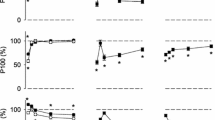Abstract
An exercise device which can be used to stimulate either paralysed or nonparalysed muscles is described. The device uses sequential activation of muscles to elicit either isometric or isotonic contractions. Feedback sensors provide the relative position of the joints of the leg to a computer-controlled two-channel sequential stimulatior which regulates the activity of the muscles. The computer can be programmed to preprogram workouts so that the muscle can move throught patterns of activity requiring either isometric exeroise, isokinetic exercise or isotonic exercise. In all cases the computer controls the entire exercise program and automatically terminates when the muscle is fatigued. THis device could be used for any type of physical therapy involving active stimulation of muscle.
Similar content being viewed by others
References
Guttman, R. (1976)Spinal cord injuries, comprehensive management and research. Blackwell Scientific Publications, Oxford.
Hudlicka, O., Brown, M., Cotter, M., Smith, M. andVrbova, G. (1977) The effect of long-term stimulation of fast muscles on their blood flow, metabolism and ability to withstand fatigue.Pflügers Arch.,369, 141.
Kao, C., Bunge, R. andReier, P. (1982)Spinal cord reconstruction. Raven Press.
Kralj, A., andJaeger, R. J. (1982) Posture switching enables prolonged standing in paraplegic patients functionally electrically stimulated. Proceedings of the Fifth Annual Conference on Rehabilitation Engineering, Houston, 22nd–26th Aug., 60.
Lind, A. R. andPetrofsky, J. S. (1978) Development of tension in fast and slow muscles in the cat during asynchronous stimulation.Nerve-Muscle,1, 213–218.
Marsolais, E. B. andKobetic, R. (1982) Functional walking of paralyzed patients by means of electrical stimulation. Proceedings of the Fifth Annual Conference on Rehabilitation Engineering, Houston, 22nd–26th Aug., 61.
Muller, E. A. (1932) Das Arbeitsmaximum bei statischer Haltearbeit.Arbeitsphysiologie,5, 605.
Peckham, P. H. (1976) Control of contraction strength of electrically stimulated muscle by pulse width and frequency modulation.Eng. Med. Biol.,18, 116.
Peckham, P. H., Mortimer, J. T. andvan der Meulen, J. P. (1973) Physiologic and metabolic changes in white muscle of cat following induced exercise.Brain Res.,50, 424.
Petrofsky, J. S. (1978) Control of the recruitment and firing frequencies of motor units in electrically stimulated muscles in the cat.Med. & Biol. Eng. & Comput.,16, 302–308.
Petrofsky, J. S. (1979) Sequential motor unit stimulation through peripheral motor nerves in the cat.—Ibid.,17, 87–93.
Petrofsky, J. S., Glaser, R. M., Phillips, C. A. andGruner, J. A. (1982) The effect of electrically induced bicycle ergometer exercise on blood pressure and heart rate.The Physiologist,25, 253.
Petrofsky, J. S. andPhillips, C. A. (1979) Constant-velocity contractions in skeletal muscle by sequential stimulation of muscle efferents.Med. & Biol. Eng. & Comput.,17, 583–592.
Petrofsky, J. S. andPhillips, C. A. (1982) Closed loop electrical control of movement. Proceedings of the Fifth Annual Symposium on Neural Regeneration, National Spinal Cord Injury Foundation, Sept.
Petrofsky, J. S., Rinehart, J. S. andLind, A. R. (1976) Isometric strength and endurance in slow and fast muscles in the cat.Fed. Proc.,35, 291.
Pette, D., Smith, M. E., Staudte, H. W. andVrobova, G. (1973) Effects of long-term electrical stimulation on some contractile and metabolic characteristics of fast rabbit muscles.Pflügers Arch.,338, 257–272.
Rack, P. M. H. andWestbury, D. R. (1969) The effects of length and stimulus rate on tension in the isometric cat soleus muscle.J. Physiol.,204, 443–460.
Riley, D. A. andAllin, E. F. (1973) The effects of inactivity, programmed stimulation, and denervation of the histochemistry of skeletal muscle fiber types.Exp. Neurol.,40, 391.
Salmons, S. andVrbova, C. (1969) The influence of activity on some contractile characteristics of mammalian fast and slow muscles.J. Physiol. (London)201, 535.
Solomonow, M., Foster, J., Eldred, E. andLyman, J. (1978) Proportional control of paralyzed muscle.Fed. Proc.,37, 215.
Vodovnik, L. andGrobelnik, S. (1977) TI multichannel functional electrical stimulation—facts and expectations.So. Prosthet. Orthot. Int., 1,1, 43–46.
Author information
Authors and Affiliations
Rights and permissions
About this article
Cite this article
Petrofsky, J.S., Heaton, H.H. & Phillips, C.A. Leg exerciser for training of paralysed muscle by closed-loop control. Med. Biol. Eng. Comput. 22, 298–303 (1984). https://doi.org/10.1007/BF02442096
Received:
Accepted:
Issue Date:
DOI: https://doi.org/10.1007/BF02442096



